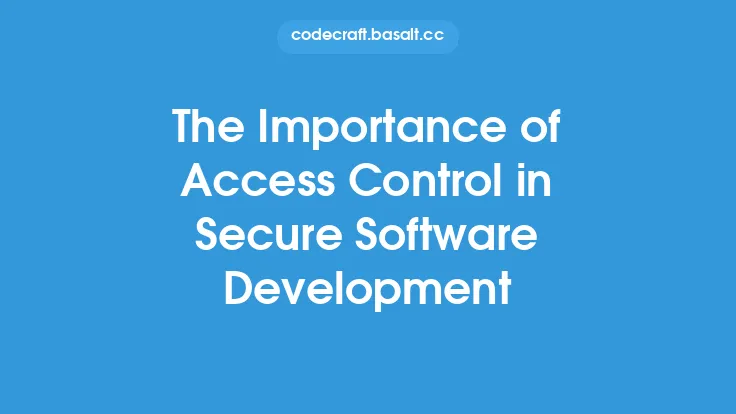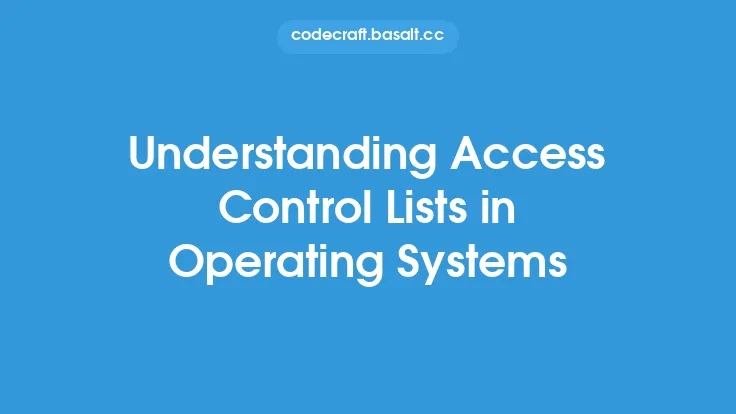Implementing role-based access control (RBAC) in software systems is a crucial aspect of cybersecurity that ensures only authorized users have access to specific resources and data. RBAC is a widely accepted and implemented access control model that simplifies the process of managing user permissions and access to system resources. In this article, we will delve into the details of implementing RBAC in software systems, its benefits, and best practices for implementation.
Introduction to Role-Based Access Control
Role-based access control is a security approach that grants access to system resources based on a user's role within an organization. In RBAC, users are assigned to roles, and each role is associated with a set of permissions and access rights. This approach simplifies the process of managing user permissions, as administrators only need to manage roles and assign users to them, rather than managing individual user permissions. RBAC is based on three main components: roles, users, and permissions. Roles are defined based on the functions and responsibilities within an organization, users are assigned to roles, and permissions are assigned to roles.
Benefits of Role-Based Access Control
The benefits of implementing RBAC in software systems are numerous. One of the primary benefits is simplified user management. With RBAC, administrators can easily manage user access to system resources by assigning users to roles, rather than managing individual user permissions. This approach also reduces the administrative burden, as changes to user permissions only need to be made at the role level. Additionally, RBAC improves security by ensuring that users only have access to the resources and data necessary for their job functions. This reduces the risk of insider threats and data breaches. RBAC also provides a clear audit trail, making it easier to track and monitor user activity.
Components of Role-Based Access Control
The components of RBAC include roles, users, permissions, role hierarchies, and constraints. Roles are defined based on the functions and responsibilities within an organization. Users are assigned to roles, and each role is associated with a set of permissions and access rights. Permissions define the access rights to system resources, such as read, write, or execute. Role hierarchies define the relationships between roles, with senior roles inheriting the permissions of junior roles. Constraints are used to restrict the assignment of users to roles or the inheritance of permissions.
Implementing Role-Based Access Control
Implementing RBAC in software systems involves several steps. The first step is to define the roles within an organization, based on the functions and responsibilities. The next step is to assign users to roles, and then assign permissions to roles. Role hierarchies and constraints are also defined to restrict the assignment of users to roles or the inheritance of permissions. RBAC can be implemented using various techniques, including attribute-based access control, policy-based access control, and identity-based access control. The choice of technique depends on the specific requirements of the organization and the software system.
Best Practices for Implementing Role-Based Access Control
Best practices for implementing RBAC include defining roles based on the functions and responsibilities within an organization, assigning users to roles based on their job functions, and regularly reviewing and updating role assignments and permissions. It is also essential to implement role hierarchies and constraints to restrict the assignment of users to roles or the inheritance of permissions. Additionally, it is crucial to provide training to administrators and users on the use and management of RBAC. Regular audits and monitoring of user activity are also necessary to ensure the effectiveness of RBAC.
Technical Considerations for Implementing Role-Based Access Control
From a technical perspective, implementing RBAC in software systems requires careful consideration of several factors. One of the primary considerations is the choice of programming language and development framework. The choice of language and framework should support the implementation of RBAC, with built-in features for role-based access control. Another consideration is the use of databases and data storage systems. The database should be designed to support the storage of role and permission information, with efficient querying and retrieval mechanisms. Additionally, the software system should be designed to support the integration of RBAC with other security mechanisms, such as authentication and encryption.
Common Challenges and Limitations of Role-Based Access Control
Despite the benefits of RBAC, there are several common challenges and limitations to its implementation. One of the primary challenges is the complexity of defining roles and permissions, particularly in large and complex organizations. Another challenge is the need for ongoing maintenance and updates to role assignments and permissions. RBAC can also be inflexible, making it difficult to adapt to changing organizational needs and requirements. Additionally, RBAC can be vulnerable to attacks, such as privilege escalation and role-based attacks.
Future Directions and Trends in Role-Based Access Control
The future of RBAC is likely to involve the integration of emerging technologies, such as artificial intelligence and machine learning. These technologies can be used to improve the efficiency and effectiveness of RBAC, with automated role assignment and permission management. Another trend is the use of cloud-based RBAC solutions, which provide scalability and flexibility in the management of user access to system resources. Additionally, there is a growing need for RBAC solutions that support the Internet of Things (IoT) and other emerging technologies. As software systems continue to evolve and become more complex, the importance of RBAC will only continue to grow, making it an essential component of cybersecurity strategies.





